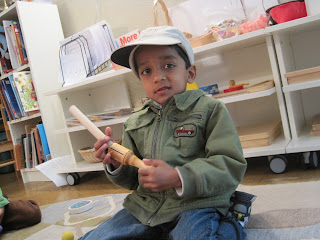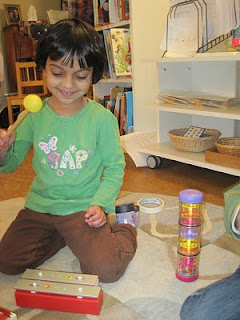Thursday, March 11, 2010

Language Development & Syntax: Week 10 FOL
The way a word is said and the context in which it is used gives a word additional meaning. Music helps a child learn to more effectively communicate and understand the meaning of language. Through musical play children learn the difference and use of loud, soft, fast, slow, etc. These are skills that allow them to more effectively color words to communicate a specific meaning. Music also helps build vocabulary. Not only are the songs we sing exposing children to new words but the words we use to explain movement enhance their descriptive vocabulary. For example, in Kindermusik we don’t just turn, we twirl, whirl, swoop, swish, etc. Music is a fun way to help a child understand the subtle meaning of language.
Monday, March 8, 2010

Rocking: Week 9 FOL
Rocking has many benefits for the infant and young child. It soothes, provides rhythmic motion, promotes muscular strength, control, balance and helps develop lateralization. Lateralization is a fancy term meaning the coordination between the right and left sides of the body. Rocking also helps a child learn to feel and keep a steady beat. Children need to be able to keep a steady beat to run well, play a musical instrument, and even to cut efficiently with scissors, so rock away! (The Infant and Toddler Handbook, Kathryn Castle, Ed.D. )
Monday, March 1, 2010

Great Sources for Instruments!
I’ve had several parents ask me about good sources for instruments at home. Of course there is always Kindermusik International, http://www.kindermusik.com/Shop/Shop.aspx, but you can also check out: http://www.beyondplay.com, http://www.DiscountSchoolSupply.com/, http://www.empire-music.com, http://larkinthemorning.com, http://www.WestMusic.com.
Buying instruments for your child to play with at home is a great idea. If you purchase instruments I suggest that you don’t leave them out all the time. Give your child a special time or times each day to pull them out and play with them. During their “music time,” play their Kindermusik CD. You’ll enjoy watching all the ways your child plays music.


Miss Mindy's March Music Note: SINGING
Children's spontaneous singing is a delight to hear. As children sing they are learning both rhythmic and melodic patterns and developing an understanding of the meaning and coloring of language. Although some children can match pitches from toddlerhood, most children need many singing experience over a long period of time to develop this skill.
To help your children learn to sing on pitch, pick a note and sing it, then have them sing it with you. A good note to start with is G. You can sing, la, la, la, or if you want to teach them solfege sing “sol”, you could also sing there name or a favorite toy. Don’t stress if they can’t match the pitch it takes practice. Just like learning to speak it comes bit by bit. Helping them learn to sing on pitch should be fun and only done for short periods of time. Make it play!
